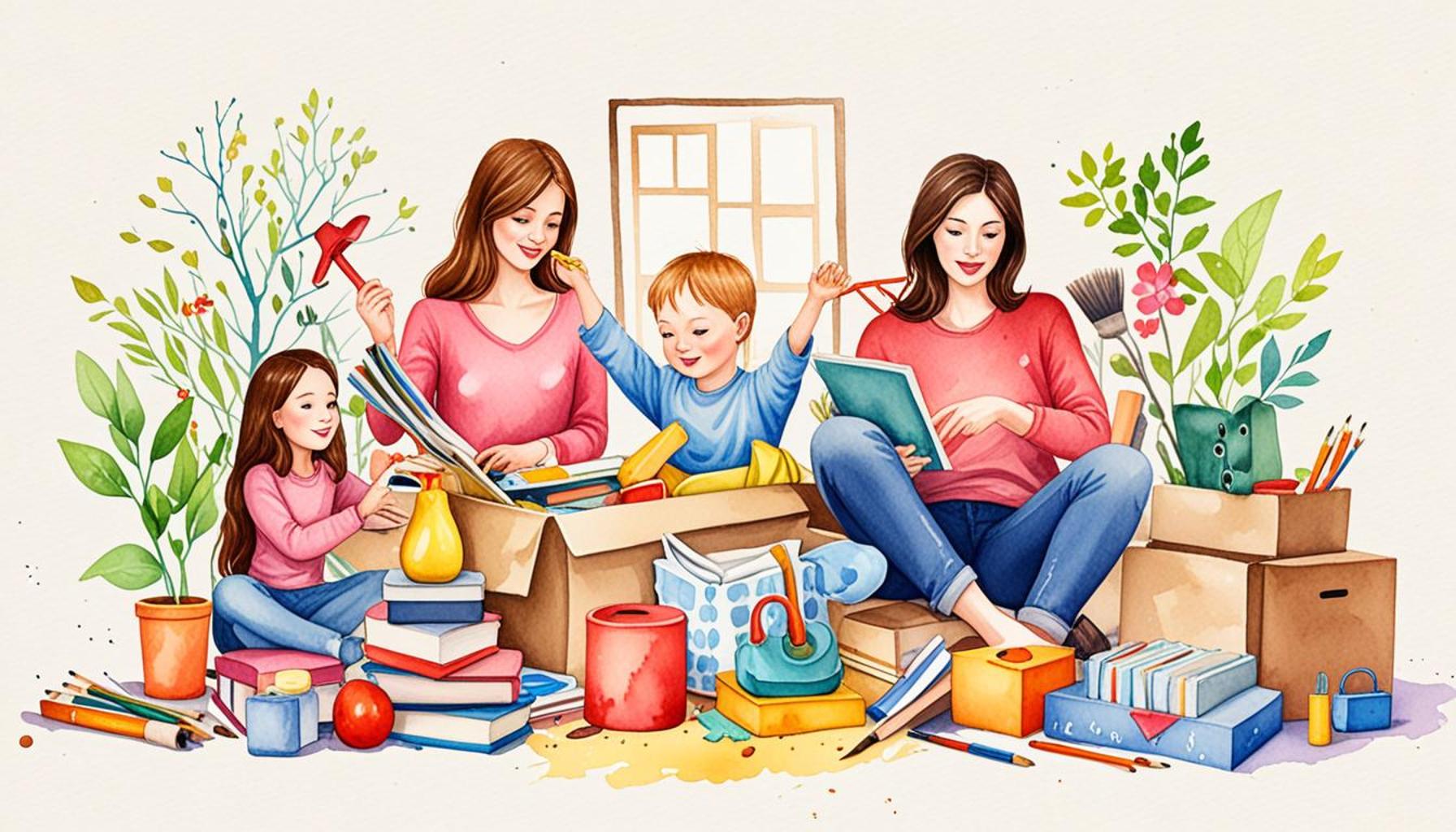Decluttering Techniques for Families: Organizing Together and Strengthening Bonds

Creating Harmony Through Decluttering
In the hustle and bustle of modern life, many households often find themselves inundated with clutter. This chaos can not only affect the physical space but also the emotional well-being of family members. To combat this issue, families can turn to effective decluttering techniques that not only streamline their living environment but also enhance interpersonal relationships.
Decluttering as a family presents an opportunity to engage in a meaningful activity that transcends mere tidying up. When families collaborate on organizing their home, they reap numerous benefits, such as:
- Shared Responsibility: By involving every family member in the cleaning process, the burden does not fall on a single person. This shared effort cultivates a sense of teamwork and accountability.
- Valuable Life Skills: In the process of decluttering, children learn essential skills such as organization and planning. They gain insights into the importance of maintaining a clean space and the joy of giving through donating items.
- Emotional Connection: Engaging in a communal activity fosters deeper emotional ties. As families reminisce over old toys or discuss what to keep and what to donate, they create lasting memories together.
In many Nigerian households, certain areas tend to accumulate unnecessary items, leading to a cluttered environment. Common clutter hotspots include:
- The living room, which often becomes a catch-all area for children’s toys and misplaced items.
- The kitchen, which can easily be cluttered with unused appliances, pots, and pans that have outlived their usefulness.
- Wardrobes, often bursting with clothes that have not been worn in years, presenting a perfect opportunity for donations.
To effectively tackle these clutter hotspots, families can implement specific decluttering techniques. For example, adopting the “one in, one out” rule can help maintain balance; for every new item brought into the home, an existing one should be let go. Additionally, setting aside time each month for a family decluttering day can turn a mundane task into an enjoyable event filled with laughter and cooperation.
As families navigate through this process, it is essential to celebrate small victories. Whether it’s successfully clearing out a single room or filling a donation bag, recognizing these achievements can significantly foster motivation. With each step toward an organized home, families will likely notice a transformation in their relationships as well, building a foundation of teamwork and collaboration. Embrace the journey of decluttering, and experience not only a more organized home but also a more united family!

LEARN MORE: This related article may interest you
Effective Decluttering Techniques for a Harmonious Home
When it comes to decluttering techniques for families, it’s essential to approach the process with a plan that involves everyone. Successful decluttering not only clears space but also integrates fun and creativity into what might otherwise be seen as a chore. The journey begins with understanding the importance of breaking down tasks into manageable sections while considering the unique needs of Nigerian families.
One of the most effective strategies is the “Four-Box Method.” This technique involves using four distinct boxes labeled “Keep,” “Donate,” “Trash,” and “Sell.” By categorizing items in this way, family members are encouraged to participate actively in decision-making, making the process engaging for everyone, from parents to children. This method not only streamlines the process of sorting but also allows for meaningful conversations about the value of items in one’s life.
Another vital technique is the “15-Minute Tidy.” Set aside just 15 minutes each day for decluttering tasks. This short and impactful time frame makes the activity less overwhelming and encourages consistency. It can be as simple as tackling a cluttered corner of the living room or organizing a kitchen drawer. This technique teaches children that maintaining a tidy space is an ongoing effort rather than a daunting task.
Families might also benefit from defining specific areas in the home that need extra attention. Here are some practical suggestions for common clutter hotspots:
- The Dining Room: A place where memories are made over meals can quickly become chaotic with items like backpacks or mail piling up. Encourage family members to create dedicated spaces for personal belongings.
- The Bathroom: Often overlooked, bathrooms can harbor a vast assortment of old toiletries that are no longer used. Making it a family project to evaluate what needs to stay and what should go can lead to a fresher, more organized space.
- The Children’s Play Area: Set aside time as a family to go through toys. Not only does this foster play-based learning, but it also helps children understand the significance of sharing and donating to those who may benefit from their old toys.
This approach to decluttering will naturally lead to discussions about personal preferences and emotional attachments to certain items. Engaging in such dialogue fosters a deeper understanding among family members, reinforcing communication skills that are vital in nurturing robust family bonds.
Finally, consider making decluttering a celebratory occasion. End each decluttering session with a family gathering to enjoy a treat or a fun activity. This not only solidifies the importance of the task accomplished but also associates the process with positive memories, making it more likely for families to stick to a decluttering routine in the future.
By implementing these effective decluttering techniques, families can transform their homes into organized sanctuaries while simultaneously strengthening their relationships. The benefits of shared experiences go far beyond the physical space, blending organization with connection.
Embracing Teamwork in Decluttering
One of the most effective decluttering techniques for families is to approach the task together as a team. This collective effort not only makes the process faster but also enhances family bonds. When family members engage in decluttering, they create opportunities for communication and collaboration. This shared experience helps to teach children valuable lessons about responsibility and organization while also allowing parents to model effective decision-making skills.
Incorporating Fun into the Process
Decluttering does not have to feel like a chore. Families can turn the task into a fun activity by incorporating games or challenges. For example, set a timer and see who can declutter a specific area the fastest, or create a system of rewards for completed tasks. Making decluttering enjoyable can motivate everyone to participate actively, leading to a more successful and engaging experience.
Establishing Clear Goals
When families decide to declutter together, it’s important to establish clear goals. Setting objectives, such as “We will declutter the living room today” or “Let’s organize our toys by the weekend,” provides a sense of direction. This goal-setting approach not only guides the decluttering process, but it also creates a sense of accomplishment when milestones are reached. Ensuring that all family members agree on goals fosters teamwork and accountability, reinforcing those precious familial bonds.
Celebrating Achievements
Once the decluttering is complete, take time to celebrate the achievements. Whether it’s enjoying a family movie night in a tidier space or engaging in a fun outing, acknowledging the effort boosts morale and encourages future teamwork. Celebrations serve as a reminder to children about the rewarding benefits of working together, making them more inclined to keep their spaces organized in the future.
| Category 1 | Category 2 |
|---|---|
| Team Effort | Creating a collaborative decluttering experience enhances family communication and connections. |
| Motivation | Fun activities and games keep the energy high, encouraging everyone to engage in the process. |
Engaging the whole family in decluttering not only keeps living spaces organized but also strengthens family ties. By communicating goals, celebrating achievements, and making decluttering enjoyable, families can tackle clutter together, creating a harmonious home environment.
ADDITIONAL INSIGHTS: Expand your understanding here
Building Teamwork Through Decluttering Activities
The process of decluttering can serve as a powerful tool for fostering teamwork within a family unit. Engaging in decluttering activities together not only helps to organize your physical space but also encourages collaboration, communication, and problem-solving skills among family members. To make the most out of this collaborative journey, families can implement “Theme Days” tailored to specific decluttering needs.
For instance, designating a specific day each week as “Toy Toss Tuesday” or “Wardrobe Wednesday” creates anticipation and excitement about the task ahead. Families can pre-plan these theme days to align with everyone’s schedule. On Toy Toss Tuesday, for example, family members can review all toys, deciding which ones to keep, donate, or throw away. This structured approach adds an element of fun, turning a chore into a family bonding experience.
In addition, introducing a friendly competition can boost motivation. Families could set a timer and see who can declutter the most items in a set period. For instance, using the “10-Item Challenge,” each family member can set out to find ten items they no longer use or need. To make things competitive, they can even share their findings, and the person who identifies the most unique items can receive a small reward. Naturally, this technique encourages children to think critically about their belongings while engaging them in a healthy, playful competition.
Furthermore, incorporating educational elements into decluttering can enhance the experience for children. Teaching them about the significance of recycling or the benefits of donating gently used clothes and toys can turn decluttering into a lesson in social responsibility. For example, Nigerian families can emphasize the cultural importance of giving back to the community through charity, highlighting local organizations that accept donations of clothes and household items. This not only lightens the clutter but also cultivates empathy within children, showing them the impact of their actions on those around them.
Another engaging method to streamline decluttering efforts is by creating a “Family Declutter Calendar.” This visual representation allows each family member to see and select which tasks they would like to participate in during the week or month. Each individual can mark their availability and preferred tasks, leading to a more organized approach where everyone has a say in what areas need attention. Whether it’s tackling the garage or sprucing up the family photo albums, this initiative helps children learn the importance of planning and responsibility.
Lastly, as families gather items to declutter, documenting the process through photos or even journal entries can create lasting memories. Families can establish a scrapbook highlighting their decluttering journey, complete with pictures of before and after scenes. This not only serves as a physical representation of their efforts but can also be revisited on special occasions, reinforcing the strengths built during the activity.
Utilizing these strategies not only leads to a tidier home but also solidifies family bonds, paving the way for a nurturing and collaborative environment. The act of decluttering morphs from a mundane task into a shared adventure that can transform relationships while creating a lifestyle of organization and cooperation.
ADDITIONAL INSIGHTS: Expand your understanding here
Conclusion: The Transformative Power of Decluttering for Families
In summary, the journey of decluttering as a family extends beyond simply tidying up your living space; it serves as a profound opportunity to nurture relationships and foster teamwork. By embracing strategies such as themed decluttering days, friendly competitions, and the incorporation of educational elements, families can create an engaging environment that binds them closer together while instilling valuable life skills in children. The experience transforms mundane tasks into exciting adventures, reinforcing communication and collaboration.
Moreover, the cultural significance of giving back to the community through donations in Nigeria underscores the importance of social responsibility, turning decluttering into a lesson steeped in empathy and awareness. As families navigate their decluttering journey, they not only cultivate a sense of organization and responsibility but also build lasting memories together.
Ultimately, the act of decluttering symbolizes more than just physical space management; it encapsulates the essence of teamwork, reflection, and shared goals. As families take on this journey together, they uncover the hidden potential not only in their homes but in their relationships as well. By prioritizing collaboration and communication, families can discover that with each item removed, they are also clearing pathways to stronger, more meaningful connections. Embrace these decluttering techniques, and watch as your family bonds flourish amidst the newfound order in your lives.



